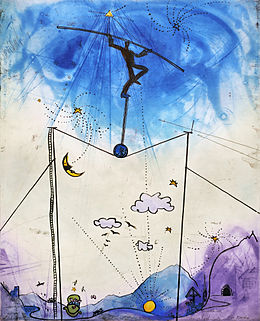Biography
![]()
This article or section is still missing the following important information:
all non-European traditions: China (different genres of bibliography from dynastic histories to modern literature), Arabic region (Sīra and others), etc.
Help Wikipedia by researching and adding them.
A biography or biography (ancient Greek βιογραφία biographia, compound of βίος bíos, German 'life' and graphie, from γράφω gráphō, German 'to carve', 'to paint', 'to write') is a description of a person's life. Biographies can be oral or written tracing a person's life story. A special case is the autobiography written by the person himself, possibly with the assistance of a ghostwriter.
Sometimes autobiographies are added to the will; a trace of life should remain - the descendants should know what was. The rapiarium is a kind of autobiographical short report.
Describing the course of life also includes the possibility of the subsequent construction of a certain meaningfulness of the life described. This leads to the question of the subjectively understood life. Every person creates his or her own biography in different life situations (during a job interview, when establishing personal relationships, or more generally when reviewing one's own life, e.g. with a psychologist or psychiatrist). Biographies also form an important tool for remembering other people. They are therefore the subject of literary and historical studies, sociology, education, psychology, medicine and theology. The individual fields and subjects of biographical research are very heterogeneous and have developed their own research traditions.

Adi Holzer: Lebenslauf (1997). The artist graphically translates the course of life as a balanced tightrope act.
Autobiography
→ Main article: Autobiography
An autobiography ("self-description") exists when the biography is written by the person in question himself or herself, or at least he or she is considered the author. Many celebrities also had the help of a professional ghostwriter.
An important autobiography is the Monumentum Ancyranum of the Emperor Augustus from the year 13 AD, which has been preserved almost in its entirety as an inscription.
The first of the self-examinations of the Roman emperor Marcus Aurelius already contains a great deal of autobiography. The first autobiography in the true sense is considered to be the "Confessiones" ("Confessions") of Aurelius Augustine; he wrote them in the years 397 and 398.
Autobiographical texts also include memoirs ("memories"). In them, the emphasis is often more on the outstanding events of interest to the general public, and the author takes a broader view of all the people involved.
Gerontology and biography
Towards the end of their lives, many people feel the need for a life review; they reflect on their lives and want to appreciate them in their entirety and understand them as meaningful. People are guided to review their lives in various settings, including life review therapy and biography work (see Maercker & Forstmeier 2013). A distinction is made between an external biography, which can be structured objectively on the basis of dates and periods of time, and an internal biography, which assesses events and developments subjectively.
In professional care for the elderly, the biography brings advantages in "personalising" the patients/clients in the home, who until then had been relatively anonymous. For many people move in there without their life story being known. They initially appear as a collection of problematic situations and not necessarily as a personality that has matured over decades. Relatives who could be questioned about this are sometimes not known. The biography there is therefore initially like a jigsaw puzzle with many empty spaces that can only gradually be filled in with the events of the individual's life.
Search within the encyclopedia